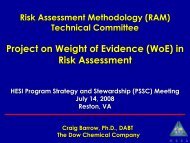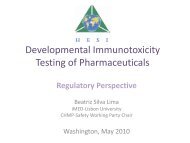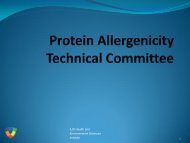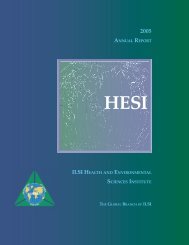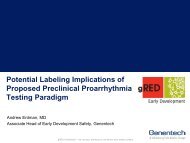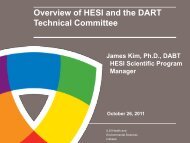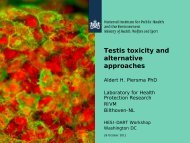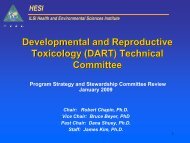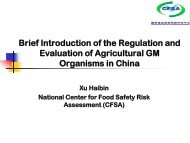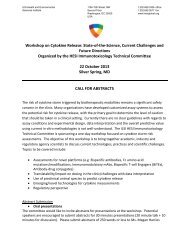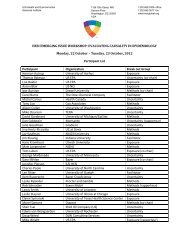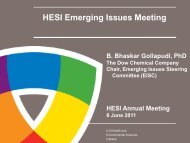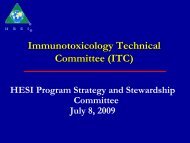Dr. A. Robert Schnatter, ExxonMobil Biomedical Sciences, Inc.
Dr. A. Robert Schnatter, ExxonMobil Biomedical Sciences, Inc.
Dr. A. Robert Schnatter, ExxonMobil Biomedical Sciences, Inc.
You also want an ePaper? Increase the reach of your titles
YUMPU automatically turns print PDFs into web optimized ePapers that Google loves.
HESI SUBCOMMITTEE ON EVALUATINGCAUSALITY IN EPIDEMIOLOGIC STUDIESA. <strong>Robert</strong> <strong>Schnatter</strong>, <strong>Dr</strong>PH(<strong>ExxonMobil</strong> <strong>Biomedical</strong> <strong>Sciences</strong>, <strong>Inc</strong>.)Subcommittee Steering Team MemberJune 8, 2011Emerging Issues MeetingHESI Annual MeetingAlexandria, VAILSI Health andEnvironmental <strong>Sciences</strong>Institute
Advantages and disadvantages ofepidemiology studiesPROHuman (not animal)Real life exposuresAddress multiplehypotheses at onceCONSubject to bias,confoundingExposure misclassificationHypothesis generatingILSI Health andEnvironmental <strong>Sciences</strong>Institute2
ISSUE:Causation in epidemiology studiesGovernment and advisory bodies increasingly recommend that allavailable evidence from toxicological, clinical and epidemiologicalstudies be combined in quantitative risk assessments.BUT…There is significant disagreement on what constitutes relevant andclear epidemiologic evidence for causation.WHAT SHOULD BE DONE?‣ The largely qualitative causal criteria for causation need a 21 stcentury “makeover.”‣ A modern approach that combines Bayesian statisticaltechniques with innovative methods for causal inference basedon potential outcomes may offer a novel process for weight ofevidence evaluations.ILSI Health andEnvironmental <strong>Sciences</strong>Institute3
CausalityCausality as a CONCEPT‣ No universal agreement -- “causality” itself is not welldefined‣ Must agree before used in weight of evidenceCausality in PRACTICE‣ Are results true or false positive?– Are results true or false negative?– Science: shades of gray, probabilityEmotions can overwhelm the process…ILSI Health andEnvironmental <strong>Sciences</strong>Institute4
Subcommittee initiationMay 2010Proposal presented at HESI Annual MeetingSeptember 2010Proposal selected by EISC for HESI actionOctober 2010Leadership TeleconferenceNovember - December 2010Steering Team teleconferencesFebruary 2011First Steering Team face-to-face meetingTeleconferences continue…ILSI Health andEnvironmental <strong>Sciences</strong>Institute5
Subcommittee Steering TeamINDUSTRY‣ Carol J. Burns (Dow Chemical Company) – Chair‣ A. <strong>Robert</strong> <strong>Schnatter</strong> (<strong>ExxonMobil</strong> <strong>Biomedical</strong> <strong>Sciences</strong>)‣ J. Morel Symons (DuPont)ACADEMIA‣ Stephen R. Cole (University of North Carolina at Chapel Hill)‣ James E. Klaunig (Indiana University) – EISC ScientificAdvisor‣ Leonard Ritter (University of Guelph)GOVERNMENT‣ Mary Ko Manibusan (US EPA Office of Pesticide Programs)‣ Enrique F. Schisterman (NIH National Institute of ChildHealth and Human Development)ILSI Health andEnvironmental <strong>Sciences</strong>Institute6
Subcommittee MissionMISSION: Organize a symposium with publishedproceedings to stimulate a dialogue regarding themethods and issues related to evaluating causality, aswell as interpretation of evidence from publishedepidemiology studies.Objective: Strengthen the value and impact ofepidemiologic studies in quantitative health riskassessments by fostering agreement on what constitutesclear and relevant epidemiologic evidence for causation.ILSI Health andEnvironmental <strong>Sciences</strong>Institute7
Subcommittee ParticipationACADEMIA (n=7)Aarhus University HospitalHarvard School of Public HealthIndiana UniversityMcGill UniversityUniversity of AarhusUniversity of GuelphUniversity of North Carolina, Chapel HillGOVERNMENT (n=7)CDC ATSDRMedical Research CouncilNIEHSNIH / NICHDUS EPA NCEAUS EPA OPPUS FDA CDERILSI Health andEnvironmental <strong>Sciences</strong>InstituteINDUSTRY (n=10)Bayer CropScienceBristol-Myers SquibbDowDuPont<strong>ExxonMobil</strong> <strong>Biomedical</strong> <strong>Sciences</strong>GlaxoSmithKlineMonsantoProcter & GambleShell HealthSyngenta Crop ProtectionCONSULTANTS (n=1)DLW Consulting Services8
2011 – 2012 Work Plan‣ Steering Team is exploring dates for a 2011 meetingof the full Subcommittee (possibly in conjunctionwith a university causal inference workshop orsociety meeting)‣ Steering Team and Subcommittee will work towardsa 2-day public workshop in conjunction with theJune 2012 Society for Epidemiologic Research(SER) Annual Meeting in Minneapolis, MN‣ Workshop manuscript for publication in peerreviewedjournal (late 2012)ILSI Health andEnvironmental <strong>Sciences</strong>Institute9
2012 WorkshopPURPOSE: The purpose of the workshop is to stimulate adialogue on evaluating causality in epidemiologic studies ina risk assessment context by bridging the gap betweentheory and practice and engaging multi-disciplinary expertsfrom the epidemiology, medical, and toxicologycommunities.Potential Discussion Topics:‣ Existing framework for causation and shortcomings (e.g., Bradford Hillcriteria for causation)‣ Novel quantitative approaches to evaluating causality in epidemiology(e.g., Bayesian analysis, counterfactuals, causal diagrams)‣ Weighing alternative data (e.g., laboratory, molecular, high-throughputdata) in causality evaluationsILSI Health andEnvironmental <strong>Sciences</strong>Institute10
Thank you!Staff contact:Nancy G. Doerrer, MSHESI Associate Directorndoerrer@hesiglobal.orgILSI Health andEnvironmental <strong>Sciences</strong>Institute11



